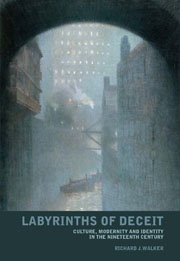Book contents
- Frontmatter
- Contents
- Acknowledgements
- Introduction: Tracing the fragments of modernity
- Part I (De)Generating doubles: duality and the split personality in the prose writing of James Hogg, Robert Louis Stevenson and Oscar Wilde
- Part II The stripping of the halo: religion and identity in the poetry of Alfred Tennyson, James ‘B. V.’ Thomson and Gerard Manley Hopkins
- Introduction
- 4 A life of death: Alfred Tennyson's ‘St Simeon Stylites’
- 5 But what am I? Alfred Tennyson's In Memoriam
- 6 All is vanity and nothingness: James ‘B. V.’ Thomson's haunted city
- 7 Dead letters: Gerard Manley Hopkins's ‘Terrible Sonnets’
- Part III Infected ecstasy: addiction and modernity in the work of Thomas De Quincey, Alfred Tennyson, Christina Rossetti and Bram Stoker
- Conclusion: Ghost-script
- Notes
- Bibliography
- Index
5 - But what am I? Alfred Tennyson's In Memoriam
from Part II - The stripping of the halo: religion and identity in the poetry of Alfred Tennyson, James ‘B. V.’ Thomson and Gerard Manley Hopkins
- Frontmatter
- Contents
- Acknowledgements
- Introduction: Tracing the fragments of modernity
- Part I (De)Generating doubles: duality and the split personality in the prose writing of James Hogg, Robert Louis Stevenson and Oscar Wilde
- Part II The stripping of the halo: religion and identity in the poetry of Alfred Tennyson, James ‘B. V.’ Thomson and Gerard Manley Hopkins
- Introduction
- 4 A life of death: Alfred Tennyson's ‘St Simeon Stylites’
- 5 But what am I? Alfred Tennyson's In Memoriam
- 6 All is vanity and nothingness: James ‘B. V.’ Thomson's haunted city
- 7 Dead letters: Gerard Manley Hopkins's ‘Terrible Sonnets’
- Part III Infected ecstasy: addiction and modernity in the work of Thomas De Quincey, Alfred Tennyson, Christina Rossetti and Bram Stoker
- Conclusion: Ghost-script
- Notes
- Bibliography
- Index
Summary
It brings us face to face with atheistic science; the faith in God and Immortality, which we have been struggling to clear from superstition, suddenly seems to be in the air: and in seeking for a firm basis for this faith we find ourselves in the midst of the ‘fight for death’ which In Memoriam so powerfully presents.
William Black, in the table of causes of admission to Bethlem madhouse documented in Dissertation on Insanity cited at the start of this discussion, notes that the most prominent factor instigating mental illness is ‘Disappointments, Grief’. In Memoriam, a collection of lyrics written between 1833 and 1850 and published anonymously at the end of May in the latter year, is an elegaic response to the death of Tennyson's closest friend during his Cambridge days, Arthur Henry Hallam, who died on 15 September 1833 in Vienna. Where ‘St Simeon Stylites’ represents religious turmoil and inner dislocation stemming from a possibility that there is no meaning behind the excesses of self-mortification, similar expressions of self-doubt and religious disorientation in In Memoriam are a result of the fact that the poem is comprehensively overshadowed by grief and the personal disruption that this emotion involves. Bernard Reardon describes the poem as
the utterance of a mind torn by doubt of whether life has any moral meaning whatsoever; a doubt made all the heavier by the sorrow of a desolating bereavement. […]
- Type
- Chapter
- Information
- Labyrinths of DeceitCulture, Modernity and Identity in the Nineteenth Century, pp. 137 - 154Publisher: Liverpool University PressPrint publication year: 2008

